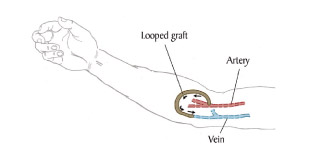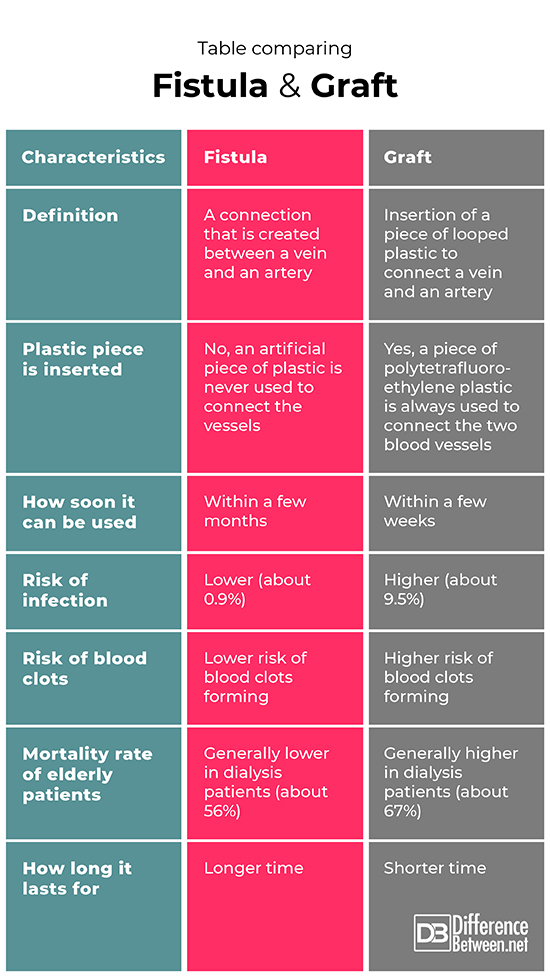Difference Between Fistula and Graft
A fistula is a connection that can be formed between a vein and an artery for dialysis. A graft is a piece of plastic that is inserted to connect a vein and an artery for dialysis.
What is Fistula?
Definition:
A fistula is an abnormal connection that is formed between an artery and a vein that can be artificially created in patients who need kidney dialysis. Where it is made for dialysis, it is referred to as an arteriovenous (AV) fistula and it provides vascular access for needles to be placed so that the blood can be cleaned by hemodialysis. Patients with kidney failure need hemodialysis in order to stay alive.
Where it is formed:
Surgeons create the fistula connection between a vein and artery in the lower arm of a person needing hemodialysis for kidney treatment. The procedure is done in an outpatient setting, often, and it takes a few months before it can be used for the hemodialysis.
Advantages of an AV fistula:
Some advantages of using an AV fistula for dialysis patients is that it decreases the chances of blood clots forming. It also reduces the risk of infection and enables a good flow of blood for the dialysis procedure. A study showed that infection rates were about 0.9% for patients with an AV fistula which is much lower than the average 9% infection rate of grafts. This form of vascular access is often the first type that a doctor will try in patients who need to have dialysis.
Disadvantages of an AV fistula:
The fistula takes quite a long time to fully develop such that it can be safely used for dialysis. This may mean the person has to rely on having a central venous catheter for a longer period of time than if they had a graft in place.
What is Graft?
Definition:
A graft is a loop that is artificially created and inserted in order to connect an artery and a vein for dialysis treatment. It is often referred to as an arteriovenous (AV) graft. The loop is made of plastic, usually polytetrafluoroethylene (and is grafted from the vein to the artery).
Where it is formed:
The graft is placed between an artery and vein in the lower arm of the patient by a vascular surgeon. The procedure is often done on an outpatient basis and the graft can be used within a few weeks for dialysis.
Advantages of an AV graft:
An AV graft is a good and viable alternative to a fistula in patients who are unable to have an AV fistula for one reason or another, or if the fistula fails. The AV graft can also be used relatively quickly, within a few weeks, and is ready much sooner than is a fistula. Scientists have found that it is a good alternative for vascular access when patients can’t have a fistula procedure done.
Disadvantages of an AV graft:
Scientists have found that using an AV graft has a higher risk of blood clots forming than if a person uses an AF fistula. The graft also seems to be associated with a greater risk of infection, hospitalizations and even death among the elderly (persons over 70 years of age). Studies have found infection rates of up to 9.5% in patients with AV grafts.
Difference between Fistula and Graft?
Definition
A fistula is some type of connection that is formed between an artery and a vein. A graft is a connection that is made using plastic to connect a vein and an artery.
Plastic piece is inserted
A piece of plastic is never used to connect a vein to an artery in a fistula. A piece of plastic is always used and it is usually of polytetrafluoroethylene plastic, to connect a vein and an artery in a graft.
How soon it can be used
A fistula can only be used after a few months for dialysis. A graft can be used for dialysis within a few weeks.
Risk of infection
The risk of getting an infection using a fistula for dialysis is lower. The risk of infection when using a graft for dialysis is higher.
Risk of blood clots
A fistula has a lower risk of blood clots for dialysis patients. A graft has a higher risk of blood clots for dialysis patients.
Mortality rate for elderly patients
An AV fistula has a lower mortality rate for elderly dialysis patients. An AV graft has a higher mortality rate for elderly dialysis patients.
How long it lasts for
In general, the AV fistula lasts longer. In general, the AV graft does not last as long as the fistula.
Table Comparing Fistula and Graft
Summary of Fistula Vs. Graft
- A fistula and a graft are both ways of gaining access to the blood vessels so that hemodialysis can be done.
- Fistulas are normally done first and then if this does not work, a graft is done.
- There are advantages and disadvantages to having an AV fistula versus an AV graft.
- The AV fistula has a lower risk of infection and blood clots and seems to last longer.
- The AV graft, though, can be used much sooner than can the fistula which takes a much longer time to mature.
- Difference Between Rumination and Regurgitation - June 13, 2024
- Difference Between Pyelectasis and Hydronephrosis - June 4, 2024
- Difference Between Cellulitis and Erysipelas - June 1, 2024
Search DifferenceBetween.net :
Leave a Response
References :
[0]Image credit: https://commons.wikimedia.org/wiki/File:Hemodialysis_graft.gif
[1]Image credit: https://upload.wikimedia.org/wikipedia/commons/thumb/c/c0/Radiocephalic_fistula.svg/500px-Radiocephalic_fistula.svg.png
[2]Lee, Timmy, et al. "Vascular access type and clinical outcomes among elderly patients on hemodialysis." Clinical Journal of the American Society of Nephrology 12.11 (2017): 1823-1830.
[3]Miller, Paul E., et al. "Predictors of adequacy of arteriovenous fistulas in hemodialysis patients." Kidney international 56.1 (1999): 275-280.
[4]UCSF Department of Surgery. “Vascular access for hemodialysis.” UCSF Department of Surgery, University of California San Francisco. https://surgery.ucsf.edu/conditions--procedures/vascular-access-for-hemodialysis.aspx



